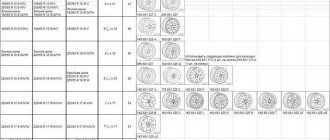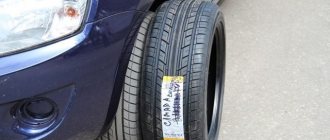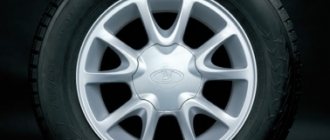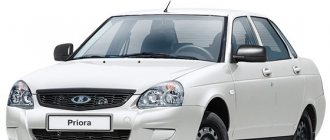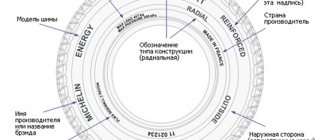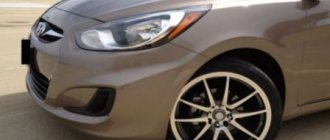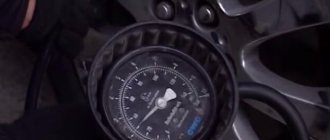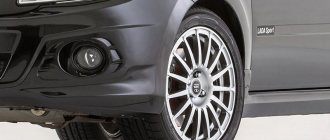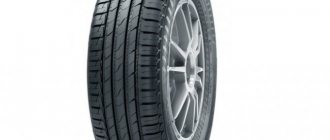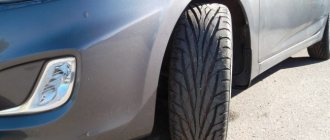The pressure in Hyundai Solaris tires for radius 15 is exactly the same as for R16. For 1st generation models, the manufacturer assigned 2.2 bar (32psi, 220 kPa) to the front and rear wheels. The manufacturer considers it necessary to check this parameter regularly (once a month), including on the spare wheel. It is carried out on cold wheels - the car should not be driven for at least three hours, or driven no more than 1.6 km.
In 2017, Solaris 2 appeared. The factory-recommended pumping increased to 2.3 bar (33psi, 230 kPa). In the compact rear wheel it was 4.2 bar. (60psi, 420 kPa).
The trunk volume and vehicle weight have increased slightly. The tightening torque of the wheel nuts has changed. It increased from 9-11 kgf m to 11-13 kgf m. The instructions were also enriched with recommendations for correcting this parameter. In anticipation of colder weather, it is allowed to add 20 kPa (0.2 atmospheres), and before traveling to mountainous areas, you should take into account the drop in atmospheric pressure (if necessary, pumping up will not hurt).
The standards can be found on a plate, usually located in the doorway on the driver's side. Compliance with them is the key to fuel economy, controllability, and safety.
A strong decrease in pressure in the slopes leads to overheating of the tire, its delamination, and failure. This may cause an accident.
A low tire increases rolling resistance, increasing wear and fuel consumption. An overinflated tire is more susceptible to road terrain and is at greater risk of damage.
On a smooth highway, it is preferable to inflate the wheels more than on a country road, but only slightly. You can add 0.2 bar for better roll-up, no more. No one has canceled the wear of the tread in the middle part at high pressure and on the sides at low pressure. If you deviate from the factory recommendations, the tire life will definitely decrease. An increase in traction qualities as a result of an increase in the contact patch is relevant only when the quality of the road deteriorates very strongly in extreme situations (you need to get out of a snowdrift or mud). Increased fuel consumption is guaranteed. In other cases, it is irrational and inconvenient.
Solaris tire pressure monitoring system
The model uses an indirect type control setup. Unlike a direct-acting system, it does not measure the pressure in each tire, but records a dangerous change based on the speed of rotation of the wheel.
When air compression in a tire drops, the wheel flexes more and the rubber rotates at a smaller radius. This means that in order to cover the same distance as a working ramp, you need to rotate at a higher frequency. The car wheels are equipped with frequency sensors. ABS has corresponding extensions that record their readings and compare them with control values.
Although simple and inexpensive, TPMS is characterized by low measurement accuracy. It only alerts the driver about a dangerous drop in pressure. The technical characteristics of the car do not indicate the critical drop in air compression and the speed required for the system to operate. The unit cannot detect the pressure drop when the vehicle is stopped.
There is a low pressure indicator on the dashboard, combined with a TPMS fault. Another icon is on the LCD. The SET reset button is located on the control panel to the left of the driver.
Advertisements on NN.RU – Auto
Manufacturing of a broken-type platform with retractable ramps on the GAZ-33023 Gazelle-farmer chassis. Technical characteristics of the tow truck.
With us you can not only extend the frame to fit a body of 5.1 m, 6.2 m, 7.5 m, 9 m for Maz Zubrenok, Maz, Kamaz, Ural, Zil, Mitsubishi, Nissan.
A specialized company for the conversion of trucks produces extensions for man man, iveco and iveco truck tractors.
A certified truck conversion organization invites you to: lengthen, re-extend and convert, p.
New Year is a magical holiday. Everyone wants to please with a pleasant gift. The main thing is to correctly distribute expenses: to please everyone.
How to reset the low pressure error in Solaris slopes: what to do
If the pressure symbol lights up and a message appears about low pumping in the ramps, you need to stop quickly, while avoiding sudden maneuvers and changes in speed. Next you need to check the actual pressure. Visual inspection should not be relied upon. Use a pressure gauge. Often a wheel that is on a slight bump will appear to be partially flat, while a tire with a strong sidewall will not sag very much when it loses pressure. If the malfunction is confirmed, it must be eliminated by inflating, repairing, or replacing the wheel. After this, reset the system.
If the wheel is normal, you also need to reset the system. It is performed using the “SET” button after the pressure has been brought up to the standard, and in strict accordance with the operating instructions, which are guidance documentation for the driver. It also lists situations in which this procedure must be performed. It should be studied in detail.
Hyundai Solaris tire pressure chart
| Dimension | Front | Rear | |
| Solaris 1 | 185/65 R15 | 2.2 bar. (32psi, 220 kPa) | 2.2 |
| 195/55 R16 | 2.2 | 2.2 | |
| Solaris 2 | 185/65 R15 | 2.3 | 2.3 |
| 195/55 R16 | 2.3 | 2.3 | |
| T125/80 D15 | 4.2 | 4.2 |
Pressure standards in winter and summer are the same.
Specialization: Graduated from the State Automobile University, worked for 20 years at GAZ-56, now I drive a Zhiguli.
Today the TPMS (Tire Pressure Monitoring System) worked for the first time. Quote from the description: “Designed to warn of dangerous changes in tire pressure. There are two types of tire pressure monitoring systems: indirect and direct pressure measurement. The simplest, from a design point of view, is the indirect pressure measurement system, which is a software extension of the ABS system control unit. The operating principle of this system is based on the fact that a flat tire has a smaller radius and, accordingly, travels less distance in one revolution than a working tire. The wheel speed sensors of the ABS system determine the distance covered by each tire per revolution. The sensor signals are compared in the ABS unit with control parameters. If there is a discrepancy between the values, the indicator (control lamp) on the instrument panel lights up and a sound signal sounds. The system provides adaptation to changes in tire pressure parameters in the event of their replacement or maintenance work on the chassis - the so-called. system calibration. When driving in a new quality, the system evaluates and remembers the tire parameters. The calibration process gradually turns into monitoring new tire pressure parameters. The advantages of an indirect tire pressure measurement system are the absence of additional structural elements and the associated low price. At the same time, the system has significant limitations in operation, including not determining the pressure before moving, has low accuracy and a high threshold (30%) for the detected pressure deviation.”
I didn't have a signal. Visual indicators only (p. 1) Stopped. I looked at the wheels - they seem to be normal. Since there were a couple of kilometers left to go home, I decided to drive there. And there is no hurry to figure it out. Measurement with a pressure gauge showed that the pressure in three wheels was 2.3 bar. And in the right rear it is 2.35. A difference of 0.05 bar is approximately 2.17%, which is much more accurate than the 30% from the TPMS description. This makes me happy. I equalized the pressure and reset the system by holding the SET button (p. 2) for 4 seconds. Hold it until the inscription appears: “Tire pressure values have been saved” (p. 3) I assume that at maintenance “0” the pressure was checked and perhaps the wheel was slightly overinflated. There are no other explanations.
When the tires are optimally inflated, the low tire pressure warning light (TPMS) does not light up on the vehicle's dashboard. However, in some cases it lights up even if the pressure is normal. This can't help but irritate, especially when the tires are properly inflated. In our article today we will figure out how to reset the tire pressure error.
Possible negative factors
In addition to the fact that such factors affect the performance and life of your vehicle, it is also unsafe. Therefore, such problems should not be neglected.
Agree, it is much more profitable to prevent a problem than to spend money on repairing it later. Therefore, a technical inspection of your vehicle should be carried out in a timely manner.
Is the most important thing drivers can do for their tires. In just one month, a tire can lose up to 0.3-0.5 atmospheres of air pressure. It is important to check the air pressure regularly to ensure that your Nissan's tires are not under-inflated or over-inflated at the same time.
| Automobile model | Years of production | Tire size | Front tire pressure (atm./psi) | Rear tire pressure (atm./psi) |
| 2010-2014 | 205/60 R16 | 2,3/33 | 2,1/30 | |
| Juke | 2010-2014 | 215/55 R17 | 2,5/36 | 2,2/32 |
| Pixo | 2009-2014 | 155/65 R14 | 2,2/31 | 2,0/29 |
Micra (K11) | 1992-2002 | 155/70 R13 | 2,2/31 | 1,9/27 |
| Micra (K11) | 1992-2002 | 175/60 R13 | 2,2/31 | 1,9/27 |
| Micra (K11) | 1992-2002 | 165/60 R14 | 2,3/33 | 2,0/29 |
| Micra (K12) | 2003-2010 | 165/70 R14 | 2,4/34 | 2,2/31 |
| Micra (K12) | 2003-2010 | 175/60 R15 | 2,4/34 | 2,2/31 |
| Micra (K12) | 2003-2010 | 175/65 R15 | 2,4/34 | 2,2/31 |
| Micra (K12) | 2003-2010 | 185/50 R16 | 2,4/34 | 2,2/31 |
| Micra (K13) | 2010-2014 | 185/55 R16 | 2,3/33 | 2,3/33 |
Almera | 2000-2007 | 185/65 R15 | 2,0/29 | 2,0/29 |
| Almera | 2000-2007 | 195/60 R15 | 2,0/29 | 2,0/29 |
| Almera | 2000-2007 | 195/55 R16 | 2,0/29 | 2,0/29 |
| Leaf | 2010-2014 | 205/55 R16 | 2,5/36 | 2,5/36 |
Primera (P11 - 144)Nissan Teana | 2008-2014 | 205/65 R16 | 2,2/32 | 2,0/29 |
| Nissan Teana | 2008-2014 | 215/55 R17 | 2,2/32 | 2,0/29 |
| Almera Tino | 2000-2006 | 195/65 R15 | 2,0/29 | 2,0/29 |
| Almera Tino | 2000-2006 | 205/55 R16 | 2,0/29 | 2,0/29 |
| Serena | 1992-2002 | 175/80 R14 | 2,5/36 | 2,5/36 |
| Serena | 1992-2002 | 215/80 R15 | 1,8/26 | 2,2/31 |
| 2009-2011 | 195/60 R15 | 2,3/33 | 2,1/30 | |
| Cube | 2009-2011 | 195/55 R16 | 2,3/33 | 2,1/30 |
| Cube 1.5 dCi | 2009-2011 | 195/60 R15 | 2,5/36 | 2,3/33 |
| Cube 1.5 dCi | 2009-2011 | 195/60 R16 | 2,5/36 | 2,3/33 |
Qashqai (5-seater) | 2007-2014 | 215/65 R16 | 2,3/33 | 2,1/30 |
| Qashqai (5-seater) | 2007-2014 | 215/60 R17 | 2,3/33 | 2,1/30 |
| Qashqai (5-seater) | 2007-2014 | 215/55 R18 | 2,3/33 | 2,1/30 |
| Qashqai + 2 (7-seater) | 2007-2014 | 215/65 R16 | 2,3/33 | 2,3/33 |
| Qashqai + 2 (7-seater) | 2007-2014 | 215/60 R17 | 2,3/33 | 2,3/33 |
| Qashqai + 2 (7-seater) | 2007-2014 | 215/55 R18 | 2,3/33 | 2,3/33 |
Nissan Pathfinder | 1995-2014 | 235/70 R16 | 2,3/33 | 2,1/30 |
| Nissan Pathfinder | 1995-2014 | 255/70 R16 | 2,3/33 | 2,1/30 |
| Nissan Pathfinder | 2005-2014 | 255/65 R17 | 2,3/33 | 2,1/30 |
X-Trail (T30) | 2001-2007 | 215/70 R15 | 2,0/29 | 2,0/29 |
| X-Trail (T30) | 2001-2007 | 215/65 R16 | 2,0/29 | 2,0/29 |
| X-Trail (T31) | 2007-2014 | 225/60 R17 | 2,3/33 | 2,1/30 |
| X-Trail (T31) | 2007-2014 | 225/55 R18 | 2,3/33 | 2,1/30 |
| X-Trail (T31) | 2007-2014 | 225/55 R18 | 2,3/33 | 2,1/30 |
| X-Trail (T31) | 2007-2014 | 215/65 R16 | 3,1/44 | 3,1/44 |
| Terrano II | 1993-2008 | 215/80 R15 | 1,8/26 | 2,2/32 |
| Terrano II | 1993-2008 | 235/65 R17 | 1,8/26 | 1,8/26 |
Murano | 2005-2008 | 225/65 R18 | 2,3/33 | 2,3/33 |
| Patrol GR | 1998-2011 | 235/80 R16 | 1,8/26 | 2,7/39 |
| Patrol GR | 1998-2011 | 265/70 R16 | 2,0/29 | 2,5/36 |
| Pick-up/Navara | 1998-2013 | 185/80 R14 | 3,1/44 | 4,1/58 |
| Pick-up/Navara | 1998-2013 | 205/80 R16 | 2,9/41 | 3,6/51 |
| Pick-up/Navara | 1998-2013 | 255/65 R17 | 2,2/31 | 2,5/35 |
| Pick-up/Navara (D40) | 2005-2014 | 235/70 R16 | 2,5/35 | 2,5/35 |
| Pick-up/Navara (D40) | 2005-2014 | 255/65 R17 | 2,5/35 | 2,5/35 |
| Kubistar | 2003-2009 | 165/70 R14 (reinforced tires) | 2,5/35 | 3,1/44 |
| Kubistar | 2003-2009 | 165/70 R14 | 2,7/38 | 3,5/49 |
| Kubistar | 2003-2009 | 165/75 R14 | 2,2/32 | 3,2/46 |
| Kubistar | 2003-2009 | 175/65 R14 | 2,2/31 | 2,7/38 |
| NV200 | 2009-2014 | 175/70 R14 | 2,5/35 | 2,5/35 |
| Primastar | 2002-2014 | 195/65 R16 | 3,5/49 | 3,8/54 |
| Primastar | 2002-2014 | 215/65 R16 | 3,2/45 | 3,5/49 |
| Interstar | 2002-2010 | 195/65 R16 | 3,9/55 | 3,9/55 |
| Interstar | 2002-2010 | 225/65 R16 | 3,9/55 | 4,5/64 |
| Interstar | 2002-2010 | 215/65 R16 | 4,0/57 | 4,3/62 |
| Cabstar | 2004-2006 | 195/70 R15 | 4,3/61 | 4,3/61 |
| Cabstar | 2004-2006 | 185/75 R16 | 4,8/69 | 4,7/67 |
| NV400 | 2011-2014 | 225/65 R16 | 3,9/55 | 4,6/65 |
Why do you need a tire pressure sensor?
American and European scientists conducted a study which found that most drivers do not check whether their tires are properly inflated before getting behind the wheel of a car. Only 40% of car owners perform such a check - and even then only once every 12 months. This causes a large number of accidents.
The TPMS (Tyre pressure monitoring system) system is designed to monitor tire pressure and also warn of malfunctions. If the tires are underinflated or overinflated, an error will appear on the remote control or a sound signal will appear.
What is the danger of too high or, conversely, low blood pressure? The risk of an accident increases, the car begins to consume more fuel, and the tires wear out faster.
The above devices operate on the same principle. Let's figure out how information about what tire pressure gets to the control panel.
- Each wheel is equipped with a controller. It records tire pressure data.
- Information is transferred from the sensor to the transceiver with a frequency of 2-3 seconds. The controller transmits data using Bluetooth.
- The program analyzes the received data, which must correspond to normal values. Otherwise, when the tires need to be deflated a little, the program gives a signal to the car owner. Exactly the same principle is used to transmit a signal if the tires need to be inflated.
- Depending on the device, error signals can be sound or light.
- The driver can set the limit for the operating parameters himself. As standard, the automaker makes it possible to adjust the device from 1.7–3.2 bar.
- On some car models, the TPMS system transmits data to your phone.
Let's look at how pressure is calculated using measuring instruments. Typically the sensor compares the angular rotation of the wheel. Knowing the value of this parameter, you can calculate the distance that the wheel will travel after making one rotation. Obviously, if the tires are underinflated or overinflated, the outer diameter of the wheel will be different. Visually, a person cannot detect this change. But the sensor notices even such changes. The system records non-compliance with the required parameters.
Reasons for triggering the tire pressure sensor
The sensor will still respond even though the wheel circumference has changed quite a bit. In this situation, it is necessary to find out what mechanical reason led to this. This is the only way you can eliminate the incorrect interpretation of signals transmitted by the system. This can happen because:
- the tires are not inflated enough;
- you installed another wheel, the shape, dimensions and tread of which are different;
- a “spare” was installed; its parameters also differ from other wheels;
- there is a puncture or rupture of the rubber;
- there is an uneven load on the car, as a result the car is skewed to one side;
- you have installed anti-slip chains on the wheels;
- an overload occurred on one of the axes; This happens when you drive a car uphill or down a hill, towing a trailer.
The TPMS also gives an error when you install new wheels or rotate them.
When, after these steps, a tire pressure error appears indicating imbalance, you should reset the settings and then set the main parameters. In this case, the control signal may remain even if the basic settings have been selected.
Why these problems might occur:
- Different tire pressures. Some wheel is not inflated enough or vice versa.
- The error appears because the system has crashed. It can only be reset at a service station.
- The indicator lights up when you operate the car using a sporty driving style, driving on ice or a dirt road. At the same time, as soon as you drive onto an asphalt surface or start driving the car calmly, the error disappears.
We recommend
How to reset tire pressure error? To begin with, imagine that the TPMS system is working normally and a flashing indicator indicates a problem with the vehicle's chassis. The first thing you should do is slowly release the gas. Do not brake sharply or turn the steering wheel. After the car stops, inspect the tires to ensure that the tires are not punctured or torn. You can then check whether the tire pressure is normal.
Note! The TPMS system will not always indicate a tire pressure error. For example, if the tires are slowly deflating, the system will not inform you of the problem. In the same way, she will not notice the error if the tire pressure begins to drop quickly. This usually happens if there is a tire rupture. This feature of the TPMS system is explained by the specifics of identifying and counting non-conformities.
However, in some cases, it happens that the TPMS indicator is on, but the tires are in perfect condition. How to reset tire pressure error? Let's figure it out.
Several simple ways to reset tire pressure sensor error
A complex TPMS system in some cases begins to work incorrectly. Typically, car owners observe the following picture: a tire pressure error is displayed on the display (the tire is underinflated), but in reality everything is fine with the wheel. You have to reset the tire pressure error. Otherwise, the TPMS system will not work correctly.
The reason for the malfunction may be a sensor that is “faulty.” This failure cannot be easily fixed. How to reset a tire pressure error if the gauge is flashing, you hear a beep, you become less alert and have difficulty driving? There are 4 ways to resolve this problem.
Method 1.
To reset the error, pick up a speed of 80 km/h and continue driving for another 15 kilometers.
This method is the easiest to implement. If your car has such a function, then turn on cruise control so that the speed does not change. Depending on the model of your car, you will be able to reset the tire pressure error at a speed that exceeds the specified speed. Once you have covered a distance of 15-20 kilometers, maintaining the same speed of 80 km/h, stop. Turn off the motor. When you start it again, the tire pressure error will disappear.
Method 2.
It does not matter what type of low pressure warning system is used. In any case, there will be a sensor on each wheel of your car. Sometimes it may be necessary to reboot the car's touch system. Read the vehicle's operating instructions. It contains information on how to reset the tire pressure error. Most often, the instructions indicate which button to press to perform a reset.
The ignition key must be in the lock. No need to start the car, just turn it to the “on” position (“ON”). Then press and hold the reset button, which may be located under the steering wheel. We wait for the low pressure indicator to flash 3 times. After this you can release the button. We start the car, it should run for 20 minutes. After this time, the computer will calibrate the sensors on the wheels. Now you can turn off the car.
We recommend
Method 3.
We deflate and then inflate the tires again.
Failed to reset tire pressure error using previous method? Then we inflate all tires to 0.2 bar, this is exactly the pressure that should be according to the recommendations of car manufacturers. Did the error persist? Then release the tire pressure completely.
Method 4.
Remove the battery terminals and then reconnect it to clear the error.
Each car has a computer that receives data from various car sensors, including TPMS system sensors. However, any electronics can fail. To reset the error, you will have to reboot the system, which requires turning off the power.
To do this, open the hood. There is a battery in the engine compartment. Disconnect the negative terminal from it. To perform this operation, use a wrench. Then sit in the driver's seat, turn the key to the "ON" position, but do not start the car. Now you need to press the signal for 3 seconds. This will use up the energy that remains in the electrical system of the machine. Then reconnect the battery. This way you can reset the error.
How to set tire pressure sensors
Sensors monitor what tire pressure is. However, you need to be sure that they are functioning properly. Of course, you don't need to constantly walk around with a special measuring device and find out the status of the sensors. You just need to calibrate it from time to time.
It is done quite simply. The most important thing to remember is that, depending on the make and model of your car, each wheel has pressure parameters strictly defined by the manufacturer for winter and summer. These values must be set to the sensors. How installation and configuration will be carried out depends on the controller used.
- Mechanical controller. It is convenient to use. We just screw it in instead of the cap. You don't need to configure anything else.
- Electronic controller. The installation procedure will be more complicated, because the device has a control unit. It can work autonomously or you will need to connect it to the cigarette lighter. We turn on the device in learning mode. Then proceed according to the setting algorithm specified by the manufacturer. You will have to install the device on all wheels, starting with the left front. Once the installation is complete, make sure that all sensors are displayed correctly on the monitor. Otherwise, you will have to rearrange them so that everything matches the parameters on the display.
- Internal controller. Such devices are the most difficult to install, because for this you will have to use special equipment for tire fitting. Experts do not recommend using the internal controller yourself. However, additional settings are not required if the data is read using the screen that is located directly at the control system.
To prevent tire pressure errors from appearing, it is important to calibrate (adjust the TPMS system) every time you make changes. For example, when you installed a new set of wheels, repaired tires, did balancing, etc. Using TPMS controllers is quite simple. The main thing is to read the instructions for using the device. And make sure that the tire pressure is what the car manufacturer recommends.
We recommend
Every car owner gets annoyed when the tire pressure error icon lights up on the dashboard. This indicator informs you that there is something wrong with the wheels. However, even if the tire pressure is optimal, the tire pressure error must be reset.
The fact is that if the TPMS system icon constantly indicates insufficient pressure, the driver will not be able to know when the tires actually begin to deflate. Driving becomes dangerous for both you and other road users. It is necessary to find out the cause of the malfunction as soon as possible and reset the tire pressure error. This is the only way to ensure safe operation of the vehicle.
A little about the car
Eight years is a sufficient period for car owners to comprehensively study and evaluate any car. And if the decision is made to release the next generation, it means that everything went as it should, sales are going well and all that remains is to take into account the opinions of the consumer, making the car even better. This is exactly what happened with the Hyundai Solaris.
Since this is a small class B city car, it was equipped with only two options for small engines - 1.4 and 1.6 liters. The first option, with a power of only 107 hp. was not in great demand, and therefore the number of its sales was significantly lower.
However, to work with a more powerful 1.6l engine, the automatic transmission was clearly not enough, which was the reason for some modifications to the model.
In particular, Hyundai has modernized the rear suspension several times, which has helped improve the car's stability when driving and eliminate sway on poor-quality road surfaces.
In the basic configuration, Solaris was equipped only with a 1.4 liter engine with a manual transmission, steel wheels (wheel diameter 14 inches) and only one airbag. No other security systems, including anti-lock ones, were installed on them.
Solaris 2011 (1st generation)
Three years later (in 2014), the car was restyled, and in the middle of the year the updated version was already on sale. The changes affected the gearbox, which added the number of steps, an electrical part, a steering wheel that became conveniently adjustable for reach, and new body painting options appeared.
Low tire pressure light is on: how to reset?
The low tire pressure light, also known as the TPMS, should not illuminate on the dashboard if the tire pressure is normal.
Sometimes, unfortunately, the indicator lights up in vain. Even when the tire pressure is fine. If the low tire pressure system is activated, this is indicated by a corresponding icon on the dashboard, and, depending on the make and model of the car, a message appears, which is very unnerving and annoying.
Typically, as automakers recommend, after the low tire pressure indication appears, the driver needs to check the tire pressure. If you've verified that your tire pressure is OK and the warning light on your dash hasn't gone off, here are a few ways you can try to reset the warning light.
Attention! If your car's wheels are equipped with low tire pressure sensors, when checking the tire pressure, be sure to check the spare tire, which may also have a low tire pressure sensor. If the low tire pressure system operates without pressure sensors, the spare tire does not need to be checked.
Drive at 80 km per hour for 15 km
This is probably the easiest way - drive about 15 kilometers at a speed of 80 km/h. Use cruise control to maintain a constant speed. Some vehicles reset their pressure sensors at higher speeds than others. After driving 15-20 km at a speed of 80 km/h, stop and turn off the engine. The next time you start, the low tire pressure warning should go off.
What it should be
The manufacturer recommends maintaining 225/60 R17 - 2.3 bar at the front and 2.1 at the rear, that is, on the front and rear axles. In Nissan Classic Almera 225/55 R18 tires, the numbers are 33 and 30 psi, which means 2.28 bar for the front wheels and 2.07 for the rear. That is, essentially the same as for 17-inch disks.
How to maintain an accurate indicator
If the tire pressure is low, this has a negative effect on driving the vehicle. This phenomenon contributes to increased tread wear on the outer edges of the product. It also generates excess heat, which reduces tire life.
Use your vehicle's tire pressure monitoring system (TPMS) reset button
Each wheel of the vehicle, regardless of the type of low pressure warning system used, has a sensor. Sometimes the sensory system just needs a reboot. Refer to your vehicle's manual for details on how to reset the tire pressure monitoring system. Usually the manual will tell you which button to press to clear the error.
Insert the key into the ignition and turn it to the "on" position ("ON"), but do not start the vehicle. Press and hold the reset button (sometimes located under the steering wheel) until the low pressure light flashes three times. Then release the button. Start the car and let it run for 20 minutes to allow the computer to recalibrate each sensor. Turn off the ignition.
Deflate and re-inflate your tires
If the reset button doesn't help, try inflating each tire to the vehicle manufacturer's recommended pressure plus 0.2 bar. If the icon on the instrument panel does not go out, reduce the pressure to zero.
Reinflate all tires to the correct pressure indicated on the driver's door pillar or in your vehicle manual. If the wheels are equipped with sensors, do not forget about the spare tire. Next, drive 3-5 km at a speed of 25 km/h to reset the sensor data.
Winter tires
On the side there are images of mountain peaks in the snow and markings MS, M&S or M+S . Winter tires must be certified by the state standard of the Russian Federation, since the Asian marking is designed for temperatures not lower than -5 degrees. Studded wheels behave confidently on icy roads, despite the increased noise.
Disconnect and reconnect your car battery
Your car has an on-board computer that checks all the sensors in the car (such as tire pressure monitoring system sensors) and decides what to do with that information. Just like your computer at home, sometimes electronics can experience system glitches. The fastest and easiest way to solve the problem of a computer crash is to restart it. Unfortunately, in order to reboot the computer in your car, you will have to first disconnect it from the power supply. To do this, you will need to briefly disconnect the negative (-) terminal of your car's battery.
First, open the hood of your car. Locate the battery and disconnect the negative cable from the battery. To do this you will need a wrench. After this, get into the car, turn on the ignition without starting the engine, and press the horn for about three seconds. This will drain any remaining energy stored in the vehicle's electrical system. Next, connect the negative cable back to the battery.
If the above methods do not solve the problem
Sometimes the above methods do not help to turn off the tire pressure monitoring system indicator. In this case, it is necessary to check the sensors in the tires (if any). To do this, contact your dealer or repair shop for diagnostics and replace the sensors if necessary.
The sensor may be damaged during:
- Tire service when replacing tires
- If the brake system is not working properly
- When the tires rotate
Additionally, the air pressure sensor may not be calibrated correctly, or the battery that powers the sensor may be low. In these cases, the sensor needs to be recalibrated or replaced. Take it to the dealer or dealer recommended repair shop where they will likely fix it in a few minutes with a scan tool.
Other problems
Sometimes the tire pressure light will turn on again and this indicates a bigger problem. Here's what it might mean:
- One of the tires may be leaking air slowly
- The system may have an internal fault that prevents it from functioning properly
- Wheel sensor requires replacement (in indirect/indirect tire pressure management system)
For reference:
Indirect tire pressure monitoring system
The sensors do not measure tire pressure, but their rotation speed and the distance traveled per wheel rotation. If the tire is flat or the pressure in the wheel begins to decrease, over a certain distance the wheel will make more revolutions, since the lower the pressure in the wheel, the smaller its diameter.
The indirect (indirect) tire pressure monitoring system determines how far the car has traveled per full wheel rotation. If the standard data does not comply, the system warns the driver of a possible problem with the wheel. Unfortunately, in this case the driver has no information about which wheel is likely to have a problem.
Direct tire pressure monitoring system
This tire pressure monitoring system uses sensors on the wheels to monitor the pressure in each wheel. By collecting data on pressure and its changes, the sensors transmit information to the car’s computer, which, analyzing the information received, if necessary, signals the driver about a problem in the wheel or wheels.
Criterias of choice
Each driver has his own routes, favorite roads and tire preferences. In this selection I was guided by the following characteristics:
- braking distance on wet asphalt - will protect you from troubles during or after rain,
- strong sidewall forgives bad roads and careless driving,
- comfort,
- directional stability on dry asphalt - for long trips.
I4, Petrol, 1.4i 99 hp
l4, Gasoline, 1.6i 121 hp
most often bought
Found an error in your data? Please let us know about it.
Maintenance Tips
Once the problem is resolved, you need to monitor the status of the TPMS system. To do this, you must follow simple maintenance tips.
First, if the tire requires a valve stem core replacement, select a stainless steel core. Copper rods corrode quickly. The stainless steel core costs pennies. But a sensor that has been eaten away by corrosion can cost several thousand rubles. So, by purchasing a stainless steel core, you will protect the pressure sensor on the wheel from corrosion.
Second, always keep the sensor screwed to the nipple valve stem. This protects the sensor from damage from water, dirt and road salt.
Third, avoid using aerosol fixative if possible. This can cause problems because the locking compound can get into the hole in the tire pressure sensor that allows it to measure pressure. A clogged sensor hole means it cannot measure pressure.
A lit low tire pressure light can be annoying and distracting to the driver. Also, a burning indication may indicate a malfunction in the wheels. But even if everything is fine with the wheels, a lit icon on the dashboard deprives the driver of control over the true pressure in the tires. After all, if the low pressure warning is on on the dashboard, you will not receive a message that the tire in your car has actually started to go flat.
And this already affects the safety of the driver and passengers. So it is in your interests to get to the bottom of the truth by finding out the reasons that led to the low tire pressure warning light on the dashboard. The sooner you fix this problem, the sooner you will be safe again.
Over 8 years of active sales in the Russian Federation, manufacturers have released a restyled version. And in 2022, the second generation came out in a completely new body.
With all the changes and improvements, the engineers tried to preserve the wheelbase as much as possible, ensuring the versatility of the brand and the same wheel size for Solaris.
Bolt pattern 4x100 for Solaris 2018
- The wheel bolt pattern on all modifications is the same - 4x100 with a central hole diameter of 54.1 mm. This means that the wheel is mounted on 4 studs, and the holes for them are drilled along a conventional circle line with a diameter of 100 mm. This indicator is compatible with almost all models of this class.
- The first generation Solaris cars were produced with wheel sizes of 5.5J x 14, 6J x 15, 6.5J x 16 and 6.5J x 17 with a wheel offset relative to the hub, that is, the ET indicator, of 35-52 mm. These parameters are completely preserved in the new modifications of the model, with the exception of the improved styling. Stamped wheels are covered with decorative caps, and more expensive trim levels have cast wheels with more elegant grilles that match the car’s exterior.
- The size of the Hyundai Solaris wheels, which was installed by the factory, is 175/70/R14, 185/65/R15, 195/55/R16 or 205/45/R17. The first 2 options are combined with winter wheels due to their high profile, R16 tires can be used in an all-season version, and 17-inch tires on Solaris with a minimum air gap have the best dynamic characteristics, which allows the car to provide maximum speed when driving on smooth asphalt in the warm season.
The tire size for Solaris R15 is the most popular, as it is installed in several configuration options.
- The automaker recommends that drivers pay attention to the tire speed and load indices during scheduled or seasonal wheel replacement using these values within the range of 84T - 88T. Such parameters allow you to load the tire up to 500-560 kg and accelerate the car to 190 km/h without causing deformation or rupture of the rubber for at least 30 minutes of such operation.
In order to independently determine the size of Solaris tires, drivers should study the above factory parameters, and then ensure the same or similar characteristics when purchasing a new product. Wheels for Solaris 2011
The level of tire pressure determines how the car behaves while driving on the road. Therefore it must be strictly controlled.
Any deviations will have a negative impact on the efficiency of Hyundai Solaris’s traction with the road surface, which will reduce the level of driving safety. You can avoid troubles along the way if you follow the manufacturer's recommendations.
They are indicated in the operating instructions or in the door arch where the driver sits. For Hyundai Solaris, 2.2 bar is optimal. The pressure value for the front and rear wheels is the same.
It is recommended to carry out a similar procedure every day or once a week. This will prevent tire wear and save money. Below is a table that shows tire pressure depending on the type and size of wheels.
It will be useful to owners of a Solaris car.
Pressure measurement
Remember the last time you checked the tire pressure of your car? You may remember that you recently changed your summer tires to winter ones, so there is no need to worry. How many atmospheres were pumped into you during the replacement? You don’t know this, and this is not surprising, because Russian specialists usually determine pressure “by eye”. Driving instructors strongly recommend monitoring this important indicator constantly.
The recommended tire pressure for Hyundai Solaris is 2.2 Bar or 32 psi for both front and rear wheels. Translated into units that are more understandable to us, this will be about 2.2 atmospheres. It should be added that experts recommend monitoring tire pressure simultaneously with refueling the car. Such frequent monitoring will help avoid rapid tire wear and thus save money.
The pressure level in Hyundai Solaris tires is traditionally recommended by the manufacturer and varies depending on the type and size of tires installed on the car. In most cases, the manufacturer indicates the recommendations on a plate that is fixed in the driver's door opening, or in the operating instructions. You should not follow the generally accepted opinion that nothing useful is written in the instructions.
Features of choice and size of wheels for Hyundai Solaris
The Korean car Hyundai Solaris is perhaps more popular in Russia than in Korea itself. And it’s not surprising, because this model is adapted to Russian conditions, and therefore has become more in demand than its predecessor, the Hyundai Accent.
But even this comfortable vehicle will cease to be so if the tires are chosen incorrectly. Let's consider which tires fit the Hyundai Solaris in size, and which ones are better to choose in winter and summer.
The correct selection of wheels for a Hyundai Solaris has a positive effect on the following parameters of the car:
- Service life of the chassis;
- Travel safety;
- Comfort and controllability.
In addition, the right wheels and tires will give the Hyundai Solaris a truly individual exterior.
In 2014, the Korean company Hyundai launched an updated version of the stunning sedan, the Hyundai Solaris, which has now become not only more impressive, but also powerful, surprising with its rich equipment and excellent protection system. Having captivated an audience of millions, he showed new possibilities, gathering an innumerable army of fans around him.
But the improved characteristics and changed dimensions also caused some difficulties, in particular related to the choice of wheels and tires for them. Today we will talk about how to choose tires for the rim size of a 2014 Hyundai Solaris, and about rims in general. This is an inexhaustible topic that can be discussed endlessly.
What tire sizes does the manufacturer recommend to install?
The choice of tires is a real problem for most Hyundai Solaris owners due to the fact that the “range of sizes” is limited. Driving for a long time on tires with inappropriate sizes leads to decreased vehicle control and emergency situations.
| Wheel disks | Tires |
| 15ET45 | 205/60R15 |
| 15ET44 | 195/70R15 |
| 16ET45 | 205/65R16 |
The transcript reads as follows:
- wheel rim width;
- surface diameter;
- reach length;
- tire width;
- height in percent;
- diameter of the metal rim.
The higher the disc is installed on the car, the greater the risk of skidding and reduced control efficiency. At the same time, excessively low wheels also negatively affect ground clearance, lower ground clearance, and limit the vehicle’s maneuverability.
